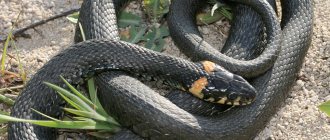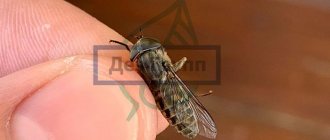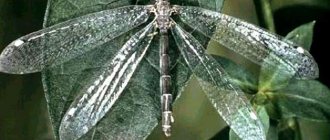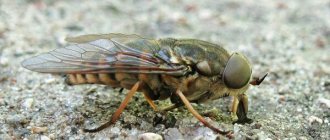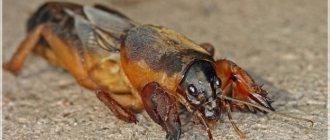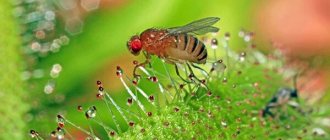The gadfly belongs to a family of insects that resembles flies in appearance. The main habitat is the tropics and subtropics; it can often be found in Russia. Insects lay eggs in the fur of animals, but they can also choose humans for this purpose. They do not pose a danger to people, but the gadfly larva can cause significant harm to the body. There are 150 species of insects in total, but only one of them is dangerous - the skin gadfly (Dermatobia hominis), which is capable of attacking people.
How do gadflies reproduce, their life cycle
Knowing that these insects are dangerous to people, they are interested in the question of how the gadfly lays eggs. This “merit” belongs entirely to females who lay eggs in the hair of animals or on human skin. This harmful insect attaches each of them to the hairs with the help of an adhesive substance, and when the larvae appear, they penetrate the skin.
Life cycle of a gadfly
Females catch ticks, mosquitoes and other blood-sucking insects, on whose abdomens they lay eggs. At the moment of a bite, the larvae of the gadfly feel warmth in a person, leave the egg, land on the skin and then penetrate under the dermis.
When the gadfly larva is introduced into animals and people, they do not experience any discomfort. The life cycle lasts about three to four months. In the first phase of their development, the larvae are in the body. Before molting, closer to the end of the second phase, they move to the back area, where fistulas appear. Through these small holes the larvae breathe and after some time emerge.
Not everyone knows how long the gadfly larva lives in a person. It develops within a month, but upon becoming an adult, it remains in the human body for about two to three months, after which it leaves it and enters the soil.
The last stage of development is pupation. While at this stage, the insect does not need food, and after 2-3 weeks an adult, the gadfly, appears. After just half a minute, females are capable of flight and reproduction. She can lay about 700 eggs, but only 1/5 hatch into larvae. A photo of the gadfly larva and the insect itself can be seen below.
The following people are most often at risk:
- not observing basic hygiene rules;
- patients suffering from mental disorders, vascular diseases, diabetes, blood flow disorders;
- drug addicts;
- alcoholics;
- children;
- elderly people;
- travelers who are keen on trips to tropical countries.
This is the answer to the question of whether a gadfly can lay larvae in a person. This is a rare phenomenon for humans; animals are most often susceptible to this.
Cutaneous human botfly and its larvae
Vectors of infections
But the main danger for animals and humans is not that horseflies drink their blood, but that they inject their saliva with toxic and anticoagulant components into the tissues. Accordingly, the blood does not clot for a long time and continues to ooze from the wound even long after the bite. But in addition to these components, horsefly saliva often contains nematodes and other bacteria. These large flies are the main carriers of such dangerous diseases as anthrax, tularemia, trypanosomiasis, filariasis, and at the initial stage of infection, people usually do not consult a doctor, believing that the ulcers and infestations growing at the site of the bite are just the consequences of a horsefly attack. Meanwhile, the treatment of all these diseases, not in the initial, but in the acute phase, can seriously undermine health.
Therefore, immediately after a horsefly attack, you should apply pressure to the bite site to reduce the spread of its saliva, cool the swollen skin with ice, rinse the wound with water and cauterize it with alcohol, brilliant green or iodine. If during the first 24 hours after the bite the redness and swelling on the skin does not subside, but rather begins to increase, then you should immediately consult a doctor.
There are about 150 species of gadflies, but 2 species are dangerous to humans, which are often found in our country.
Subcutaneous gadflies tend to lay eggs by attaching them to the hair on the animal's body. Next, the mature larvae penetrate the skin into the body and migrate through the tissues, making their way up to the back of the animal, causing myiasis. And finally, the mature larvae get under the skin of the back, form nodules with fistulas and come out. But the animal remains alive.
Why is the gadfly dangerous?
The human gadfly lives in almost any part of the body: on the head, arm, chest, leg. It can even be found in the eye and nose. But most of all they love to live in the back and armpits. The stay of the gadfly larva does not go unnoticed, since in the place where it has settled, a small bump appears, as if from a mosquito bite. After a certain period of time, pain, inflammation appears, and the lump becomes red or blue. Afterwards, an abscess is discovered, which breaks through, forming a hole for the larva, through which it gets out.
If a human gadfly lives in the body, it can pave the way to its “liberation” through the nose.
When inflammation occurs, pus appears from the wound, which leads to a sharp deterioration in health:
- weakness appears:
- a person feels nauseous:
- vomiting may occur;
- there is dizziness;
- pain appears in the muscles of the body.
If the parasite gets into the eyes, irritation of the mucous membrane occurs, eye pressure increases, and lacrimation occurs. Bleeding may accompany these symptoms. Therefore, the gadfly is dangerous for humans.
I work as an ophthalmologist. I have had cases when the subcutaneous gadfly, or rather its larva, was in the eyes of a person. Patients arrive with a headache, their eyes are watery, there is swelling and irritation. The task of doctors is to competently eliminate the parasite from the organ, which we successfully cope with.
Classification of disease types and signs of invasion
Depending on which tissues or organs are affected, myiases are divided into:
- subcutaneous;
- intestinal;
- genitourinary;
- ophthalmic;
- nasal;
- oral;
- ear
Each form has its own symptoms. What is common is a deterioration in well-being. A person experiences itching and pain at the site of penetration of the larva. Weakness, nausea, dizziness, and headache appear. Possible increase in temperature and fever.
Subcutaneous
The fly does not lay larvae under the skin, since the ovipositor is not capable of damaging the skin. The laying is done either on the surface of the skin or in existing damage. The hatched larvae independently penetrate the epidermal layer. This is how subcutaneous myiasis develops. The main symptoms are red-purple blisters on the skin (sometimes with a hole in the center). When the larvae move, the victim experiences pain and itching. Parasites can be located shallowly, in the upper layer of the skin, or penetrate deeper into the connective tissues and further into the muscles and tendons.
Intestinal or cavitary
Intestinal myiasis can be caused by almost any type of insect, even ordinary house flies. The larvae enter the human body through the gastrointestinal tract along with food. Most often, the larva dies after a few days and is excreted in feces or vomit. But sometimes (most often with low acidity) the larvae begin to develop in the intestine, penetrating its mucous membrane.
Symptoms of intestinal myiasis:
- pain in the abdomen and anus;
- nausea, vomiting;
- diarrhea;
- weight loss.
In the advanced stage, internal bleeding appears.
Urogenital
This type of myiasis appears due to the fact that fly larvae penetrate the urethra. Most often this happens after a person puts on underwear, on the surface of which the female has laid eggs. After the parasites penetrate the human body, their vital activity becomes the cause of inflammatory processes in the genitals or bladder. A common symptom is difficulty urinating, pain in the urinary canal.
Ophthalmic
Ophthalmomyasis is one of the most severe types of disease. It occurs after fly eggs or larvae enter a person's eye. Parasites penetrate into the thickness of the conjunctiva, into the mucous membrane, or even into the eyeball. This leads to pain, decreased visual acuity, and in advanced cases can cause complete blindness.
Nasal or nasal
This form of myiasis is quite rare in humans. Most often, wild animals become infected with it. In most cases, the cause of the disease is nasopharyngeal gadfly. These viviparous insects seem to inject larvae into the nostrils or eyes of the victim. The larvae invade the nasal mucosa, and then can move further and even reach the brain. Symptoms of infection:
- pain in the nose;
- increased secretion of mucus;
- frequent sneezing;
- purulent rhinitis.
As the parasites move inside the body, the location of the pain changes.
Oral
Cases where a fly has laid eggs or larvae in a person’s mouth are extremely rare. This is primarily due to the fact that foreign organisms in the oral cavity are very easy to detect. But if infection does occur, inflammation, ulcers, and fistulas appear in the mouth.
Ear shape
Otomiasis develops when a fly lays eggs inside the ear or on the surface of the auricle. You can also become infected if you sleep on linens that have eggs or larvae on them. The larvae hatching from laid eggs penetrate deep into the auricle, causing pain and hearing impairment. In severe cases, the parasites penetrate the brain.
How does deletion work?
Removing gadfly larvae is an operational procedure that must be performed by a specialist. Before proceeding with the extraction of the parasite, the doctor degreases the site of the abscess using a solution of furatsilin or another remedy indicated for this case. After this, sterile oil is dripped into the hole, which will not allow the larvae to breathe. Lack of oxygen forces her to come out. As soon as it begins to emerge from the hole, the doctor removes it using a special medical instrument and applies a bandage.
Removing gadfly larvae
A quick and effective method is surgery. Removing gadfly larvae is a painless process, as it takes place under anesthesia. The doctor makes a small incision, removes the larva, applies a bandage and prescribes a course of treatment with antibiotics. After 1-2 weeks the wound heals. Sometimes scars remain on the body.
It is not recommended to remove the larva yourself. It holds onto the tissue quite tightly and is located deep in the epidermis. If a person tries to remove it themselves, there is a possibility that part of the larva will remain under the skin. As a result, the inflammatory process and suppuration will begin.
Prevention
The larva of a gadfly under human skin can most often be found in residents and guests of tropical countries. Many people today visit America, Mexico, Argentina; in Russian regions there is also a gadfly that can lay eggs on the skin of animals and humans. You should be aware of this and need to prepare in advance. It is recommended to adhere to the following rules:
- do not appear in places where gadflies live in large numbers;
- wear clothing that protects against bites;
- use repellents that are sold in assortment in stores.
By following these simple rules, gadfly larvae will not appear in the human body. But if this happens, you should treat the wound using special means. If something starts to bother you, you should immediately consult a doctor.
Consequences
Infection with the subcutaneous botfly leads to the following consequences:
- Cows have a decrease in milk yield by approximately 7%.
- Young animals have growth retardation.
- For the leather industry - the skin of animals that have suffered from hypodermatosis has holes, which spoils the raw hides.
- For the meat industry, the capsules in which the larvae developed require removal, due to which a fairly large amount of meat is lost; sometimes, with severe contamination, about 10% of the raw materials have to be cut out.
If signs of infection are detected, animals are slaughtered exclusively in sanitary slaughterhouses.
Gadfly larvae in animals
Pets, like humans, are susceptible to various diseases. There are many cases where gadfly larvae in a dog were discovered by people. This applies to a greater extent to homeless animals. Insects lay eggs in the sand, the dog, having run around, lies down to rest, and allows them to move into the animal’s body.
Gadfly larvae were also present in the kitten. Doctors demonstrate operations to remove them in videos. The sight is not very pleasant. If animals are not brought to the veterinary service in time, they may die. If gadflies appear in the house, it is recommended to purchase products to get rid of these insects. It would also be a good idea to buy or make a trap yourself.
Among over 150 species of gadflies, only one is dangerous to humans, called Dermatobia Hominis. It cannot be found in Russia and the CIS countries - the insect is found only in countries with a tropical climate: Central America, Argentina and some areas of Mexico. A gadfly larva in a person can cause a lot of unpleasant phenomena: inflammation, suppuration, disruption of the normal functioning of body systems, and surgical intervention may be required to remove it.
How can a larva enter the body?
An adult gadfly is a fly whose size does not exceed 18 mm. It has a large head with large eyes located on it, a blue belly, orange-colored legs and transparent wings. Because of the hairs all over its body, the gadfly resembles a bumblebee.
An adult insect does not feed on anything throughout its short life, but uses the nutrients accumulated in the larval phase.
30 seconds after emergence, an adult gadfly becomes capable of flight and reproduction. One female can produce up to 700 eggs, but the larva emerges from only 1/5 of them.
The female catches mosquitoes, ticks and almost 40 species of other blood-sucking insects and lays eggs on their abdomens. At the moment when insects land on human skin, the larvae, sensing warmth, hatch from the eggs and move onto the skin, into which they are subsequently embedded. Penetration into the body is not accompanied by any painful sensations, and most often goes unnoticed by the person.
Mature larvae have special hooks on their bodies with which they are able to cling to the skin. Feeding on blood, the larvae grow, eventually reaching 1.5-2 cm. In total, the parasite lives in the host’s body from 5 to 10 weeks. After this period, they crawl to the surface of the skin and fall to the ground, where they pupate. After 2-4 weeks, an adult human gadfly emerges.
Is it possible to become infected with the botfly larva in Russia?
About 6 species of gadflies are common in Russia, and all of them prefer to choose cattle or horses as their host. However, occasionally there are cases where larvae are found in humans - in the eyes or under the skin.
Control measures
To protect domestic animals from attacks on them, gadflies try to keep the animals in stalls and under canopies during the latter’s flight, that is, during the hottest hours of the day, where gadflies usually do not fly, and to clean their skin more often to remove the testicles from it first. larvae emerge from them. If it is necessary to drive cattle out to pasture or to work at this time, it is advised to lubricate their skin with ointments, the smell of which drives away gadflies, such as: a mixture of kerosene, soap and water, or fish oil, turpentine and sulfur color, also: lard (20 parts) and carbolic acid (1 part) and, finally, some fat and sulfur color; Lubrication is carried out once or twice a week and then the gadflies do not touch the oiled cattle.
To repel viviparous nasal botflies, for example, sheep, smear the muzzles of the sheep with linseed oil (2 pounds), in which wax (1 pound) is dissolved during boiling and, after cooling, carbolic acid (4 ounces) is added, or an ointment is made from equal parts of tar and fat .
Those sheep that are already infected should be selected and killed for meat, and their heads should be thoroughly boiled to kill the larvae in the frontal sinuses. Larvae found in tumors of the skin of cattle and horses are killed by introducing into the tumor, through its openings, lumps of some fat, which clogs the spiracles of the larva and thereby kills it; they also put in lumps of gray mercury ointment or pour in kerosene, which, although it produces acute pain, also kills the larvae; you can simply remove them with your fingers, having first widened the opening of the tumor with incisions, without which the larva, which holds very firmly in its place, can be difficult to grasp; The larvae are killed at the end of winter, when the tumors become clearly visible.
To kill the larvae of the white-headed gadfly that enter the human eye, the local Kyrgyz inject into the eye, immediately after infection, an aqueous infusion of tobacco leaves, which produces severe pain, but quickly kills the larvae, and the pain goes away as soon as the eye is washed with water.
Gadflies do not drink blood, but sometimes they can be much more annoying than horse flies. Botflies are especially harmful to livestock: they often grow their larvae in the skin of animals. Gadflies parasitize different parts of the animal’s body: lips, eyes, nose. The larvae of the gastric botfly develop directly in the stomach. To penetrate the body, the female gadfly lays larvae on those parts of the body that the animal most often scratches with its teeth. Once the larva enters the mouth, it takes about a month to reach the stomach.
Some gadflies attach their larvae to the grass, through which the larva enters the animal's stomach. The subcutaneous gadfly lays larvae under the skin of the animal. For several months, the larvae move towards the back of their victim. To pupate, they emerge through a fistulous opening in the back.
Why is the gadfly dangerous?
As a result of the vital activity of a large number of gadfly larvae, the infected animal often dies, contracting pneumonia or “false whirlpool.”
Gadflies are also dangerous for humans (only one species is dangerous for humans - the human skin botfly). They can cause conjunctivitis by spraying their larvae into the eye. Sometimes the larvae penetrate not only the eyes, but also the head of a person. In this case, the victim needs surgery. As a result, a person may lose vision.
The fight against gadflies comes down to disinfestation of their most common habitats and the animals themselves. All the means we use to combat gadflies are completely safe for humans and animals, but they are fatal for parasitic insects.
How is maggot infestation treated?
The disease caused by the larvae of the human gadfly has a name - dermotobiasis.
Diagnostics
To diagnose the disease, a blood test is used to determine the amount of antibodies. The patient will be asked whether he has been to places where the disease has spread. A visual examination is also used, during which a purulent abscess with a hole is found on the skin. The doctor examines the inflammation with a magnifying glass.
Advice: If you suspect the presence of botfly larvae in your body, it is recommended to contact an infectious disease specialist or parasitologist.
Drug treatment
Before removing the larvae, the use of the antiparasitic drug Ivermectin is indicated.
Removing the larva
Removal of gadfly larvae is carried out by first washing the affected area with disinfectants (potassium permanganate, furatsilin and others). The larva is blocked from accessing oxygen by dropping a small amount of sterile oil into the hole. After this, the parasite has no choice but to come to the surface. When it protrudes from the hole in the skin, it is grabbed with special tweezers or a clamp and gently pulled out.
Important! The operation should only be performed by a doctor. The larva is located in the deep layers of the epidermis, and there are hooks on its body, and if removed roughly or incorrectly, some parts of the parasite may remain under the skin, causing inflammation and suppuration.
After successful completion of the procedure, an antiseptic bandage is applied to the damaged area of skin.
When traveling to countries with a tropical climate, you should take precautions: wear clothing that protects against insect bites and use repellents. If the bite of a blood-sucking insect could not be avoided, it is necessary to thoroughly treat the wound with a disinfectant, monitor its condition and, at the slightest deviation from the norm, consult a doctor.
The gadfly larva in humans is a parasitic phenomenon that causes significant disturbances in the functioning of the body. The most common consequences are: suppuration, tissue necrosis, inflammation of the skin, disruption of the life support system, and intoxication.
Diagnostics
It is possible to determine that parasites have entered the skin of humans and animals not only by the symptoms and reactions of the infected organism described above. Although an experienced dermatologist or infectious disease specialist will immediately make the correct diagnosis upon examination. If there is any doubt, a special blood test is performed, which shows the amount of antibodies. Are they exceeding the norm? Then it is necessary to begin pest control as quickly as possible.
What do a gadfly and its larvae look like?
Gadflies live in almost every corner of the planet; in total there are more than 150 species of insects. In our country, 60 varieties are registered. Usually, gadflies lay their larvae in the body of animals, less often they get under the skin of a person. Dermatobia Hominis - the “human gadfly” lives in the tropics (Mexico, South America, Argentina). In the temperate climate of Russia, Ukraine and the countries of the former USSR, the insect has not been observed.
The adult is a special species of fly measuring up to 20 mm. Dermatobia Hominis looks like a small bumblebee: a shaggy body and a bright orange color. The gadfly has a rather large head with pronounced large eyes, a blue abdomen, and small transparent wings.
Insects living in our latitudes usually have a calmer color: dark brown or coal-black, gray-blue. They prefer livestock as a host, but it happens that when they bite, they also infect humans.
The adult does not feed; the supply of nutrients obtained during the larval development stage is enough for the entire life cycle.
The larva after birth is very small. During the phase, it grows several times, reaching 2 cm. Its body has an oblong teardrop shape. Special hook hairs allow it to attach to the skin of animals or humans.
One adult female can reproduce up to 650 eggs, but only 20% are viable.
A species of dangerous gadfly that lives in southern countries.
Where are these insects common?
The human gadfly, judging by the developmental characteristics of the larvae, tries to live closer to places where people live or conduct active economic activities. The adult animal prefers dry and hot weather. It does not tolerate changes in temperature and humidity well.
Most often, residents of Central and South America suffer from the cutaneous botfly, but the eggs of these insects are easily transferred when moving to other countries thanks to tourists and can live peacefully there, degenerating into larvae in the host’s body. Cases of infection have been reported in Europe, Japan, China, the USA and other places where adults do not like to live.
How does a gadfly larva enter the human body?
The gadfly larva can enter the human body in several ways:
- The female lays eggs on the abdomen of blood-sucking insects (mosquitoes, ticks). When a person is bitten by intermediary insects, the eggs land on the person's body. When warmed up, they burst and larvae emerge from them, which get under the skin. The introduction of parasites is practically not noticeable.
- When a human is bitten directly by the female gadfly itself, the larvae enter the wound, after which they fully develop as parasites in the person.
- Hypodermatosis is a disease associated with these parasites. In this case, the larva is acquired tactilely from cattle. It is the countryside and farms in our latitudes that can be considered a potential site of infection. Parasites get under the skin, and they can move along the body, leaving characteristic traces. The larvae usually penetrate the body in areas where the skin is more delicate, for example, on the head, arms and legs, abdomen, neck, and less often they can concentrate on the lips and in the eye.
- Eggs and larvae can also enter internal organs. This occurs when eating animal meat contaminated with gadfly. The gastric parasite is much more dangerous than the subcutaneous larva of the gadfly, since its parasitism can lead to serious disruptions in the functioning of the body.
Horseflies
Horseflies, unlike gadflies, are equipped with a fleshy proboscis, inside of which there are hard and sharp piercing and cutting blades. This is why the bite of a horsefly is so painful for both people and animals. The skin in this area remains thick and red for several days, and a slight temperature may rise.
Only females drink blood; males use plant juices for nutrition. Unfertilized females also drink flower nectars, but to lay eggs they only need blood and as much as possible. Cases have been recorded where, after being attacked by a dozen horseflies, a person ended up in intensive care and required a blood transfusion. In terms of the amount of blood taken, the bite of one horsefly on average is equal to the bites of almost 70 mosquitoes.
Stages of larval development
The larval stage of the gadfly usually lasts 6-10 weeks. After entering the host’s body, the parasite begins to intensively feed on blood, drawing out useful substances. In a few weeks it increases in size tens of times, and the mature larva reaches 2 cm.
The photo shows a small gadfly larva extracted from a human body.
Having collected the necessary supply of nutrients from the host, the parasite breaks through the skin and crawls out. After this, a new stage of development of the gadfly begins - the pupa. In this phase, the insect arrives for 2-4 weeks, after which it turns into an adult, the life cycle of which is 20 days, the main task of the fly is reproduction.
Nutrition
The parasite larva receives nutrition while inside the victim. Adults cannot absorb food; their oral apparatus is reduced. The pest inside the victim is pear-shaped with the obligatory spines on its scales for advancement. All this is enclosed in a sclerosed capsule, with a hole at the bottom. Length reaches 25 mm, diameter 7 mm.
The basis for nutrition is blood fluid. After securing itself inside the host, the larva begins to accumulate all the useful substances for further existence. The parasite secretes a liquid mass in its body, causing severe pain and inflammation.
Symptoms of the appearance of gadfly larvae in humans
Parasites penetrate into any part of the body, their penetration at the initial stage is not noticeable at all. After 1-2 weeks, the site of penetration swells, turns red, and looks like a mosquito bite.
After another couple of weeks, the skin becomes blue, swelling appears with suppuration in the center, like the stem of an acne. The abscess bursts and the open wound allows the parasite to gain access to air.
The general health of a person infected with gadfly larvae worsens: nausea and dizziness, weakness, fever, and burning in the affected area appear.
If the larva is in the eye, tearing, redness, increased eye pressure, and less often bleeding are observed.
Less commonly, a focus of development is observed in the nasal cavity, as evidenced by pain, headaches, and swelling.
Features of life
It is not advisable to look for differences between the gadfly, horsefly and spider.
The photo of the gadfly and horsefly clearly shows that the latter are larger flies, which are equipped with two pairs of wings and large bright eyes that occupy most of the body. Gadflies are significantly smaller in size and have less colorful colors. just one pair of wings and more yellow on the body. A photo of the difference between a blind and a gadfly clearly demonstrates the external differences.
Also, gadflies and horseflies feed in different ways. Male horseflies lead a herbivorous lifestyle and prefer to feed only on plant juices and nectar. Females do the same thing. Once the female is ready to mate, she becomes very aggressive and switches to a predatory lifestyle.
Adult gadflies generally feed on it. This explains their short life cycle. Nutrition and accumulation of nutrients occurs at the larval stage. When the gadfly develops wings and the ability to mate, they begin to actively lay eggs and mate.
What harm do gadfly larvae cause to humans?
Undoubtedly, gadfly larvae cause serious harm to the human body. The degree of impact directly depends on the location of the parasites. Skin larvae disrupt the general state of health, the functioning of organs, and poison the body with waste products.
The most dangerous are cavity parasites that concentrate in the internal organs: stomach, intestines, ENT organs.
Complete blindness is threatened by the larva of the gadfly, deposited in the human eye.
It is very important to eliminate the pest at an early stage of development to minimize complications.
How to remove a botfly larva from under the skin?
Removal of the larva can be carried out in two ways:
The main task of any method is the safe removal of the foreign body. The removal operation is performed under sterile conditions. The affected area is treated with an antiseptic (iodine, potassium permanganate). A drop of sterile oil will help block air access to the larva. Once in unfavorable conditions, it will begin to crawl out of the body on its own. The parasite is pulled out using tweezers or a special clamp.
The larva crawls out from under the skin in the leg.
After removal, the wound is treated and then bandaged with a sterile cloth.
The operation must be carried out by a specialist, since if you extract it yourself, parts of the parasite may remain under the skin, which will cause inflammation and suppuration of the wound.
The safest extraction is to allow the larva to leave the host’s body on its own. To do this, use ointments, creams and oils to remove parasites.
Extracted larva and skin damage.
A course of drug treatment will allow you to provoke the release of a foreign object, affecting it through its source of nutrition - blood. Such drugs contain substances that are toxic to the parasitic organism.
How to protect yourself from gadfly larvae?
To avoid infection with gadfly larvae, you must follow simple rules:
- When traveling to southern countries where insects dangerous to humans live, you must take special insecticidal agents that repel flies (sprays, ointments, creams).
- Protective clothing and mosquito nets will help avoid contact with flies.
- Avoid contact with insects in nature and in other places where gadflies gather, for example, on a farm or in a village.
The larva of a gadfly can cause quite a few health problems if you do not consult a doctor in a timely manner. It is important to know that at the first symptoms, an examination and consultation with a doctor is necessary. Independent actions in this case are unacceptable.
- Author: Maria Sukhorukikh
Rate this article:
- 5
- 4
- 3
- 2
- 1
(0 votes, average: 0 out of 5)
Share with your friends!



